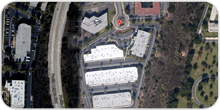Biomagnetism
- Development of babySQUID® for Neonatal Brain Assessment – NIH
- HTS Ferritometer® – NIH
- Low Cost Cryosusceptometer – NIH
- Intestinal Ischemica SQUID instrumentation – NIH
- Instrumentation for Fetal Cardiac Monitoring – NIH
- Simultaneous Fetal Echocardiography and Magnetocardiography – NIH
- Transvaginal Probe for Fetal Magnetocardiography – NIH
- SQUID-Controlled Noise Reduction Coils for Fetal Magnetocardiography – NIH
- Inverted SQUID Microscope for Neuroscience Research – NIH
Geomagnetism and UXO (Unexploded Ordenance)
- UXO instrumentation – ONR
- Pipeline assessment – GRI
Non-Destructive Test and Evaluation
- Airframe Scanner – NASA
- SQUID Array for Rate of Hidden Corrosion in Aging Aircraft – AFOSR
Electromagnetic Sensing
Optical Magnetometers
- Optical Magnetometer Operating in Earth’s Field
Other R&D
- Mixed Stage Cryocooler
- Rack Mounted Cryogenic Platform
- Spray cooler 77K
- Cryocooled SQUID sensors
Consulting Services
US Funded Research
1R43NS046964-01 Inverted SQUID microscope for neuroscience research
2R44 DK066736-02 Low cost Cryosusceptometer
1R43HD055091-01 Transvaginal probe for fetal magnetocardiography ØI
N072-150-0035 Rack Mounted Cryocooler ØI
2R44HL082017-03 Simultaneous fetal echocardiography and magnetocardiography ØII
1R43CA133997-01 SQUID magnetometer detection system for real-time tumor tracking
1R43EB008914-01 Transient Magnetic Stimulation
1R43EB008926-01 Cryocooled Biomagnetometer
5R44NS038806-04 Development of BabySQUID for Neonatal Brain Assessment
7R44DK049435-04 Magnetometry for early Dectection of Intestinal Ischemia
F49620-92-C-0026 Large Array SQUID Magnetometer for Non-Destructive Evaluation
F456220-00-C0006 AFOSR Corrosion ØII
8654 Gas Research Insititute -Pipeline detection
4000019710 &19718 UXO Oakridge/ Batelle UXO / Geometrics /Blackhawk
R01 DK57209/CFRA#93849 subgrant #1 Columbia HTS Ferritometer
1 R43 HD043542 -01 Developing Instrumentation for Fetal Cardiac Monitoring ØI
F33615-03-M-5429 MDA ØI -Microwave
1 R43 HD45106 -01 SQUID-Controlled Noise Reduction Coils for Fetal MCG ØI
2R44HD045106-02A1-N00014-04-M-0254Biomagnetism R&D
Development of babySQUID® for Neonatal Brain Assessment
Detection of cortical function in newborns is needed for clinical intervention in the early stages of neurological disorders, before external signs appear and the conditions develop and worsen. Identifying how infants learn is of interest to many sectors of society, but such studies rely heavily on behavioral analyses. Having a direct measure of cortical activity would provide precise information on the dynamic response in the brain during learning processes.
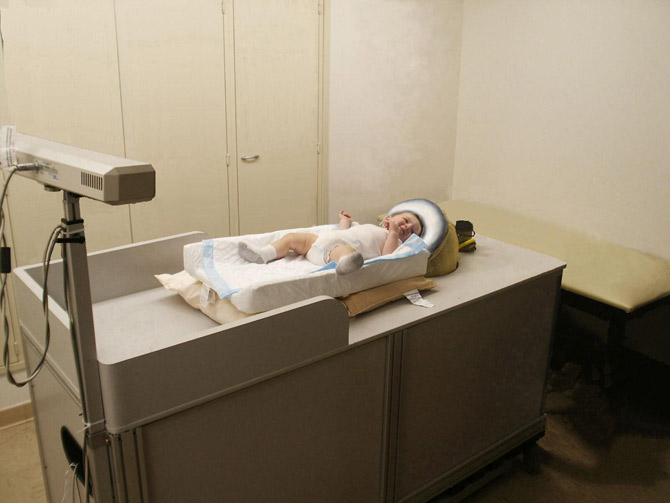
babySQUID® showing patient, bed and optical mapping system
Under NIH SBIR funding (5R44NS038806-04), Tristan developed a novel, high-resolution magnetoencephalography (MEG) system, called babySQUID®, for evaluating neurological impairments of preterm and term babies. This is a portable, non-invasive MEG system that can be used next to the bedside of any neonatal care unit without a cumbersome magnetically shielded room. The system is the size and shape of an examination table. Unprecedented spatial resolution and sensitivity was provided by a closely spaced array of superconducting MEG sensors housed 6 mm below the outer surface of the headrest. Additional details of babySQUID® can be found at http://tristantech.com/babysquid
Development of Artemis123 for Neonatal Brain Assessment
The Artemis123 MEG system is a completely redesigned and updated version of the original babySQUID system. It is similar to the original in that it is completely non-invasive, with the patient lying on a bed in full view of the nurse or mother. The helmet is expanded to allow whole-head coverage, with 123 measurement channels.
The operating system is written in LabVIEW® for rapid development and to simplify the communications with the National Instruments data acquisition boards. The software features simultaneous displays in a split-screen configuration, with continuous data on the left and averaged data on the right. The end user can customize their graphs to display the specific channels of interest, and the system is capable of displaying up to 256 channels at 5 kS/s continuously. The available filtering options in various points throughout the data stream, coupled with the ability to play back a saved data file as if it were coming in live from the A/D cards, enables the Artemis123 acquisition software to be used as a powerful post-processing tool as well.
The SQUID electronics, Tristan’s 400 series iMAG® system, has been significantly upgraded for multi-channel integration. These are conventional transformer-coupled SQUID electronics following a flux modulation scheme. Though there is not anything particularly novel about this architecture, its use grants this system with some important features. The flux modulation scheme gives the SQUIDs themselves a flat frequency response from below 0.5 Hz to in excess of 40 kHz. Transformer coupling of the SQUID voltage allows the use of high-resistivity cabling in the dewar, allowing many SQUIDs to be run inside the dewar vacuum space with minimal impact on liquid helium consumption. Furthermore, this conventional method allows for unshielded operation with linearity on the order of a part per million.
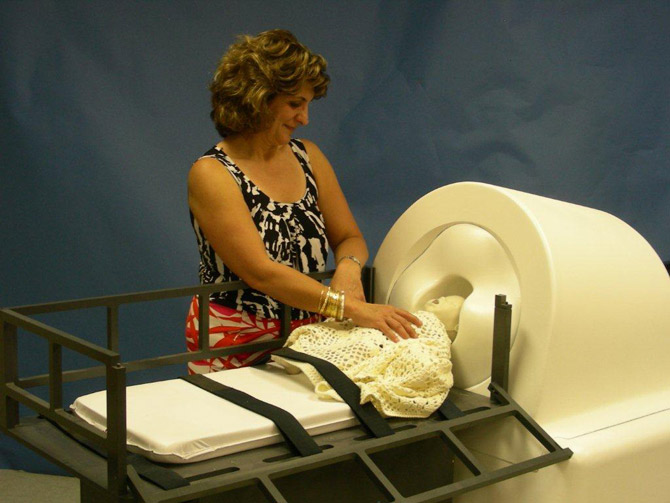
Artemis123® showing sensor and patient bed
HTS Ferritometer®
In conjunction with Columbia University’s Presbyterian Hospital, the HTS Ferritometer® program funded by the NIH under an R01 grant (R01DK57209/CFRA#93849 subgrant #1) to develop a HTS SQUID-based replacement for Tristan’s LTS Ferritometer®. A HTS SQUID sensor was coupled to a detection coil fashioned from a HTS YBCO superconducting film deposited on a flexible substrate. The magnetic, necessary for applying a mT strength field to the liver, was a NdFeB (neodynium-iron-boron) permanent magnet. Clinical trials of the prototype system are underway.
Low Cost Cryosusceptometer
In conjunction with Case Western Reserve University and Children’s Hospital in Oakland, CA (CHO), and funded by the NIH under an SBIR grant (2R44DK066736-02), the low-cost cryosusceptometer program eliminated the use of SQUID sensors, replacing them with a proprietary magnetic sensor. Closed cycle refrigeration is used to eliminate the need for transfer of cryogenic liquids, reducing operating costs and improving ease-of-use.
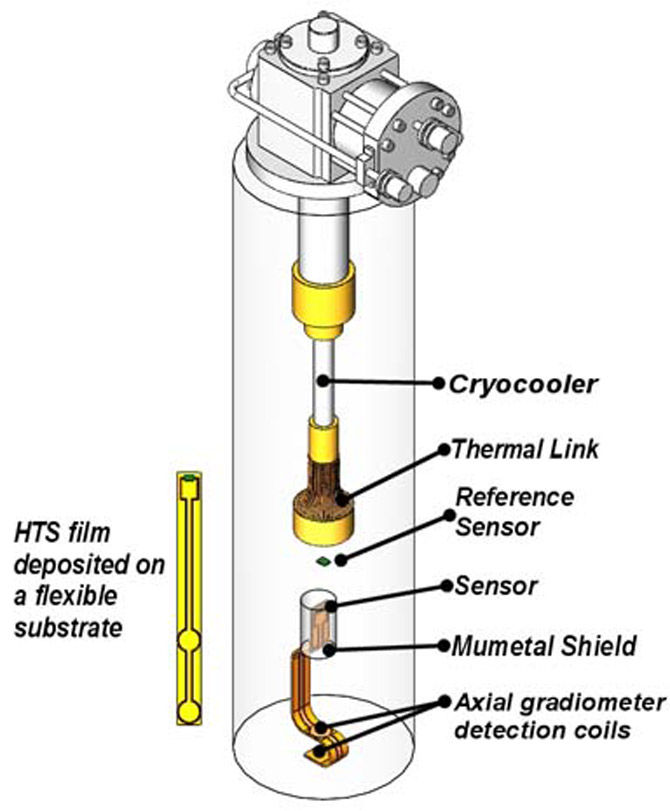
Clinical trials of the prototype system (including sensor system, closed cycle refrigerator, cryostat gantry, patient bed, computer control and analysis system) are about to begin. Measurements from the low-cost cryosusceptometer will be compared to CHO’s LTS Ferritometer®.
Instrumentation for detection of Intestinal Ischemica
Intestinal ischemia is difficult to diagnose and usually fatal. Other less serious intestinal disorders, such as Crohn’s disease, ulcerative colitis, and irritable bowel are also difficult to diagnose. Previous work on animals at Vanderbilt University has shown that electrical activity in the small intestine is highly sensitive to changes in arterial oxygen delivery and arterial blood supply. These changes are large and occur within minutes of creation of the ischemic bowel.
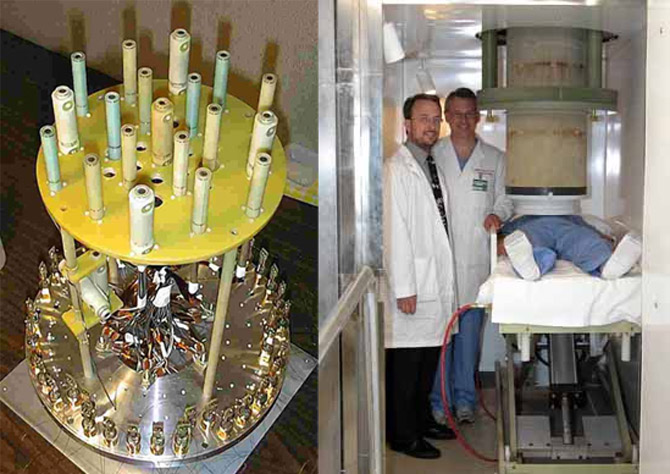
Detection coils set showing axial and vector channels Patient measurement. Preliminary magnetic measurements were made on normal human subjects using a novel, superconducting vector magnetometer that was developed during this project. The resultant system was delivered to Dr. Richards at Vanderbilt University Medical School.
This work has shown that non-invasive measurements can be made of electrical activity in the intestine and that the magnetic signal is consistent with published data taken electrically. This program was funded by the NIH under a SBIR grant (7R44DK049435-04).
Developing Instrumentation for Fetal Cardiac Monitoring
There is a strong need to assess the physiological development of the fetus, as more pre- and full-term babies survive with possible disorders. In conjunction with the University of Wisconsin and the Medical College of Wisconsin, the program was funded by the NIH under a SBIR grant (1R43HD043542-01). Tristan evaluated the feasibility of developing a new, non-invasive fetal magnetocardiography (fMCG) sensor, based on high temperature superconductors (HTS). This involved the construction of a proof-of-principle HTS axial gradiometer fMCG system using electronic gradiometers. Measurements in a magnetically shielded room showed sufficient sensitivity for fMCG measurements. As part of the program, HTS planar gradiometers were investigated and found to allow real-time unshielded measurements of adult MCG’s.
Simultaneous Fetal Electrocardiography and Magnetocardiography
Electrophysiological and mechanical interactions in the fetus are largely unstudied. There is an established need to enhance the current echocardiography/Doppler capabilities of recognizing the fetus at risk of life threatening cardiac complications. In conjunction with the University of Wisconsin and the Medical College of Wisconsin, this program is funded by the NIH under a SBIR grants (1R44HL082017-02 and 2R44HL082017-021A1). This program developed an fMCG vector gradiometer instrument specifically designed for combined use with echocardiography for the characterization of the intrauterine clinical condition of fetuses with life-threatening arrhythmias, acquired heart failure, and structural congenital heart disease. Direct simultaneous comparison of fetal magnetocardiography using Superconducting Quantum Interference Device (SQUID) magnetometry and Doppler allows, for the first time, assessment of electromechanical disturbances associated with heart failure and severe arrhythmia. This instrument directly addresses the fetal cardiac disorders that effect about 1-3% of all pregnancies.
TruckSQUID, Mobile Fetal Magnetocardiac System
Under a subcontract to Shared Medical Technology, Tristan developed a mobile version of the fMCG system that is integrated into a mobile Magnetically Shielded Room (MSR). The multi-channel fMCG system contains a custom-designed array of 7 vector gradiometer elements (dBx/dz, dBy/dz, dBz/dz) arranged in a hexagonal array. Thus a total of 21-channel channels are used for measuring the magnetic field produced by the heart of a fetus. The biomagnetometer is positioned over the abdomen of a pregnant woman to detect and measure this field. The biomagnetometer is suspended on a gantry which enables a technologist to position if over the abdomen of the woman at any location selected by the doctor.
For the fMCG biomagetometer, a baseline longer than that typically used for MEG was used due to the increased depth to the signal source. The fetal heart is typically about 4 cm to 8 cm from the sensor during typical fMCG measurement, depending on gestation stage and fetal position. To allow for variability in the source depth, vector gradiometers with ~8 cm baselines were fabricated for the instrument.
The dewar is capable of operating at tilts of up to 45 degrees, with an insert containing the 21 SQUIDs, gradiometers, and cryogenic cabling. The flat-tailed dewar design minimizes fabrication costs as well as overall tail size.
A ceiling-mounted gantry is installed in the MSR in the mobile truck. The gantry offers two degrees of transnational motion (X, Y), Z (optional), and two degrees of rotational motion (tilt and twist). Spring actuated/pneumatic release brakes on the appropriate degrees of freedom are implemented for patient safety. Furthermore, the gantry is compatible with SMT’s nonmagnetic patient bed, which may provide vertical adjustment (Z). Combined, the gantry and the patient bed facilitate X, Y, Z translation motion and tilt and twist rotation, thus providing all the necessary flexibility for the best possible positioning of the instrument.
The success of this system depends heavily on our ability to remove interference from the fMCG recordings using signal processing. Results obtained so far clearly demonstrate that this is achievable and the instrumentation further improves the effectiveness of signal processing.
Synthetic reference channel filtering was implemented with good success in a previous fMCG system. This method is extremely useful for compensating for local, non-stationary sources of interference, in contrast with reference channel methods typically employed in MEG or MCG.
For recording fMCG data readouts, Tristan has designed and constructed a modular data acquisition platform from commercially available A/D components (National Instruments, Austin, TX). These include a PXI chassis and embedded controller, which houses the 24-bit data acquisition cards.
Transvaginal Probe for Fetal Magnetocardiography
Extending the Instrumentation for Fetal Cardiac Monitoring and Simultaneous Fetal Electrocardiography and Magnetocardiography R&D efforts, and in conjunction with the University of Wisconsin and the Medical College of Wisconsin, this program (funded by the NIH under SBIR grants 1R43HD055091-01 and 2R44HL106994-02A1), is aimed at developing an instrument for transvaginal fetal cardiac and brain electromagnetic activity at gestations younger than what can be achieved using present technology of transabdomenal fetal signal recording.
SQUID-Controlled Noise Reduction Coils for Fetal Magnetocardiography
The infrastructure requirements (cost, weight, size, cramped interior spaces, etc,) for magnetically shielded rooms (MSRs) have inhibited the diffusion of biomagnetic instrumentation. Under NIH SBIR funding (1 R43 HD45106 -01), Tristan, in conjunction with Wisconsin researchers, developed a novel noise cancellation system utilizing Helmholtz coils and proprietary feedback electronics to achieve 70 dB reduction of powerline frequencies.
Inverted SQUID Microscope for Neuroscience Research
This program was funded by the NIH under a SBIR grant (2 R44 NS046964-02) is to develop a prototype inverted SQUID microscope for neuroscience research. The signal levels are expected to be much weaker (100-500 fT/√Hz) than signals in the area of non-destructive evaluation (> 1 pT) where SQUID microscopes have been used previously. The prototype system is an 8-channel magnetometer-SQUID sensory array, each magnetometer being about 0.6 mm in diameter with a field sensitivity around 70 fT/√Hz or better with the detection coils at a distance of 200 µm away from the neurons and glial cells to be studied. The microscope is similar to an inverted optical microscope except the objective is replaced by an array of superconducting miniature magnetic field sensing coils. Tristan’s cryocooled liquid ballast refrigeration technology (link to cryocooled SQUID sensors) is used to avoid the need for daily cryogen transfers.
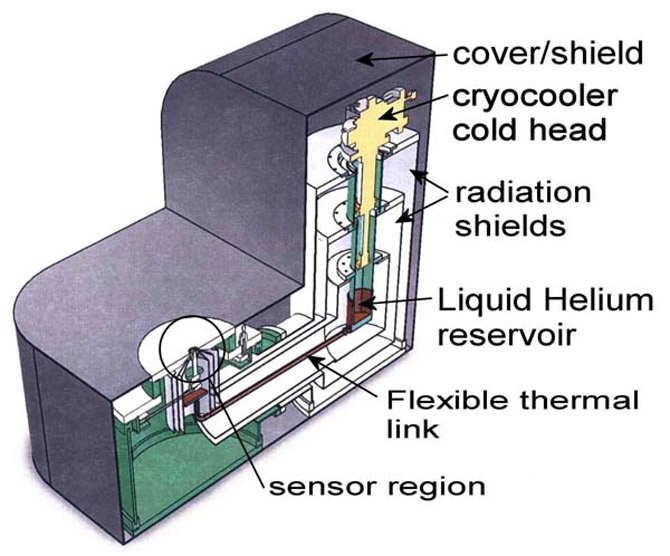
Other applications for the inverted microscope are (1) electrical currents from single neurons and glial cells in culture, (2) efficiency of bonding of antigens and magnetically tagged antibodies (immunoassay), and (3) movements and conformational changes of a small number of magnetically tagged molecules in a cell for studying signaling pathways. The proposed SQUID microscope should be useful in both academic setting and industry for understanding the electrophysiology of small cells that are difficult to study with electrodes, for drug discovery and for studying second-messenger systems.
Geomagnetism & UXO UXO instrumentation
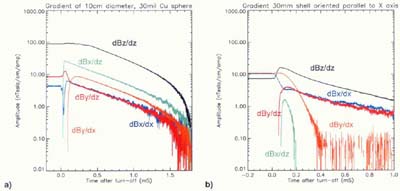 In conjunction with Blackhawk Geometrics, Oak Ridge National Laboratory and Battelle (funded by the U.S. Naval Surface Warfare Center contract N00174-98-C-0026 and subsequent contracts), Tristan developed a HTS SQUID magnetometer system for standoff detection and classification of surface and buried unexploded ordinance (UXO). The 8-element tensor system was used in conjunction with a transient electromagnetic field generator to perform TEM measurements on various UXO objects. This work is being extended to placement on an airborne platform
In conjunction with Blackhawk Geometrics, Oak Ridge National Laboratory and Battelle (funded by the U.S. Naval Surface Warfare Center contract N00174-98-C-0026 and subsequent contracts), Tristan developed a HTS SQUID magnetometer system for standoff detection and classification of surface and buried unexploded ordinance (UXO). The 8-element tensor system was used in conjunction with a transient electromagnetic field generator to perform TEM measurements on various UXO objects. This work is being extended to placement on an airborne platform
Pipeline assessment
This program, funded by the Gas Research Institute, was to design a SQUID-based Magnetic Telescope consisting of a superconducting source coil encircling a superconductive pickup loop that inductively couples magnetic flux to a SQUID sensor. There are several advantages to using superconducting technology for inspection of buried pipelines. The magnetic field of a supercurrent oscillating at several hertz in a source coil penetrates the overburden to detect defects in a pipe wall. The generated magnetic field can penetrate to depths in excess of 6 feet to illuminate defects in buried pipelines. In addition, defects can be detected in the entire circumference of the pipe, i.e. in the under side, and not just in the areas near the detection equipment. This technique can precisely locate flaws for subsequent excavation and repair. Changes in wall thickness and diameter, as well as bends and plug valves, are not deterrent factors for a Magnetic Telescope.
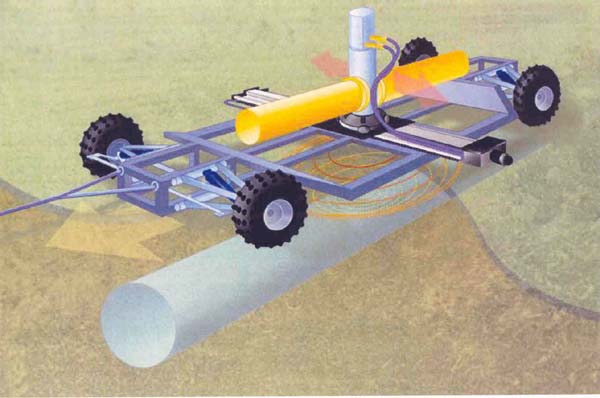
Under separate funding from a major East Coast Utility, Tristan developed a magnetic inspection system for liquefied natural gas (LNG) piping to distinguish between ferrous and non-ferrous bolts situated beneath thick insulation layers.
Non-Destructive Test and Evaluation
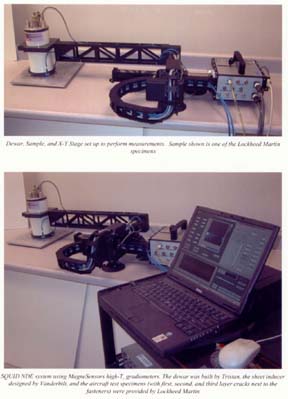 Quantitative Nondestructive Evaluation of Aerostructures Using New High Temperature SQUID Sensors
Quantitative Nondestructive Evaluation of Aerostructures Using New High Temperature SQUID Sensors
The goal of this NASA funded subcontract from Magnesensors (San Diego, CA) was to develop a new, portable NDE instrumentation capable of detecting deep level flaws in multi-layer aerostructures. The system integrated the latest technology for operating HTS in an unshielded environment with some of the most advanced eddy current techniques to produce a new, portable NDE instrument for scanning airframes for hidden defects. Deliverables included a unique compact liquid nitrogen dewar capable of cooling a HTS SQUID sensor array while oriented in any (including inverted) orientation, a remotely operable, non-magnetic scanning arm and a data acquisition system for remote operation of all aspects of the scanning system. The system also included a horizontal (Bx & By) field generator.
SQUID Array for Measurements of Hidden Corrosion in Aging Aircraft
In conjunction with Vanderbilt University and under funding by the Air Force Office of Scientific Research under a STTR grant (F456220-00-C0006), Tristan developed a new laboratory instrument that that incorporated a 2-dimensional array of SQUID magnetometers suitable for quantifying the rate at which various forms of corrosion damage accumulate in a range of aerospace structures. This technique will allow determination of instantaneous rates of hidden corrosion in aluminum aerospace structures, such as crevice corrosion in an aircraft lap joint or exfoliation corrosion in the midplane of a thick wing plank. The system has greatly increased “scanning” speeds for more precise spatio-temporal measurements.
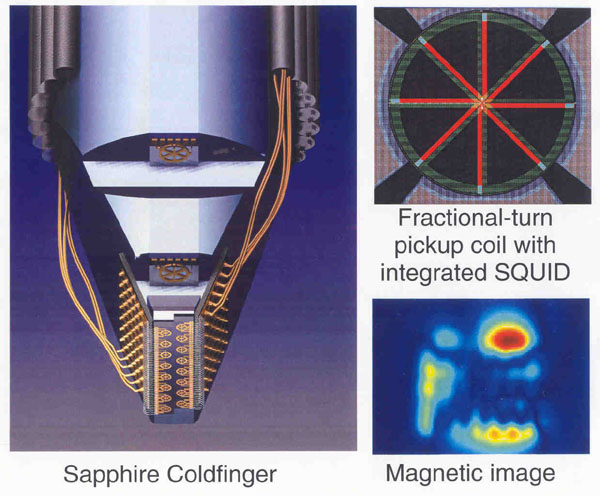
The design incorporates important technical innovations, including the use of fractional-turn SQUID sensors, improved scanning technology, and advanced analysis software. The instrument incorporates a 16-channel SQUID magnetometer system, an 8-element tensor array for noise reduction, a magnetic shield and scanning stage, and an environmental controlled corrosion cell system. The metrics developed allows the imaging of the “instantaneous” level of magnetic activity, as well as cumulative magnetic activity, indicating regions of high activity. This instrument was designed to provide data on hidden corrosion rates that will reduce the probability of hidden corrosion contributing to the failure of a structurally significant element. Its applications will be in inspection planning and maintenance, cost reduction, and increased aircraft safety and availability.
Electromagnetic Sensing
Microwave Frequency Photonic Band Gap Resonator
This program, funded by the U.S Department of Defense, developed a high Q, low phase noise resonator filter based on a Superconducting Photonic Band Gap Structure.
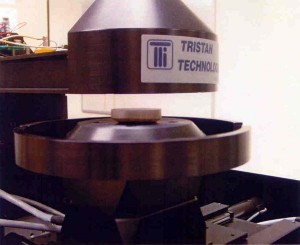
SiC ingot inside the 94 GHz resonator -{SiC_in_SRA.jpg}
Microwave Near Field Measurements
Under DOD SBIR funding (SBIR grant F33615-03-M-5429), Tristan developed a resonant microwave technique for characterization of the electronic properties of wide bandgap semiconductors used for RF applications in the X-band. A 94 GHz Fabry-Perot resonator was used to perform measurements on a number of substrates and epitaxial wafers with varying growth/processing parameters. Correlate the DC resistivity and wafer’s growth/processing parameters with the dielectric constant and losses at 94 GHz. SiC substrates with and without GaN epilayers.
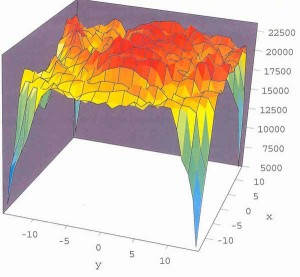
2D scan of high resistivity 450 micron thick SiC wafer. Effects due to edge of sample holder can be seen at corners of scan.
A variable temperature platform, able to accommodate 50 mm diameter, 2 mm thick wafers for high frequency EM measurements in the 25 to 600°C temperature range was also designed.
Optical Magnetometer
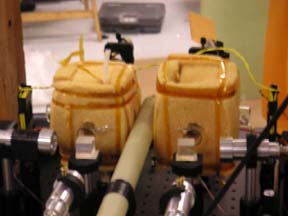
In conjunction with researchers at Princeton University, a new fT-level atomic magnetometer technology was developed under US Department of Defense funding (STTR grant N00014-04-M-0254). The device was a two-channel unshielded atomic magnetometer that was constructed and tested at Tristan. It demonstrated sensitivity of 2 pT/√Hz while operating in an industrial environment with noise level as high as 5 nT/√Hz. The intrinsic sensitivity level of the magnetometer constructed at Tristan was equal to 10 fT/rt-Hz. The major sources of noise were identified and a plan for the next generation system operating on an airborne platform developed.
Other R&D
Mixed State Cryocoolers
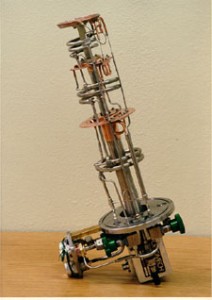 More than a decade ago, Tristan developed the first mixed stage (Gifford-McMahon/Joule-Thomson) cryocooler that routinely achieved 2 K. The technology developed by Tristan is now routinely used in the cryocooler industry.
More than a decade ago, Tristan developed the first mixed stage (Gifford-McMahon/Joule-Thomson) cryocooler that routinely achieved 2 K. The technology developed by Tristan is now routinely used in the cryocooler industry.
Rack mounted Cryogenic Platform
The electronic benefits of using cryogenically cooled and/or superconducting electronics-and 4 K electronics in particular-comes from higher potential speeds, higher signal to noise and lower thermal noise. Use of cryogenically cooled and/or superconducting electronics for shipboard, airborne, and long life stationary applications prohibits the use of liquid cryogens. In this DoD funded SBIR program, we are in the process of designing and (in Phase II) constructing a Rack Mounted Cryogenic Platform (RMCP) that will satisfy the need for packaging of signal transfer hardware for cryogenically cooled RF receivers and other superconducting electronics (SCE)
Spray Cooler
There are a number of situations (e.g., X-ray crystallography) where it is desirable to vary the temperature of a sample without direct contact to the sample. Directing a temperature regulated gas stream at the sample can accomplish this task. Tristan developed a OEM spray cooler system for a private customer that provided a wide temperature range with the ability to rapidly change the sampe temperature.
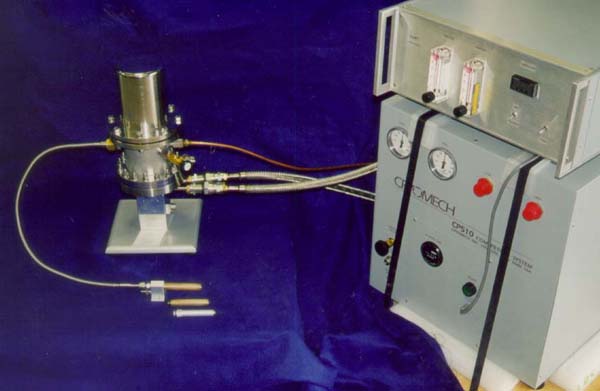
In the CryoStream® Cryogenic Spray Cooler, clean, dry nitrogen gas flows through two separate gas flow paths. One path goes through a regulating valve, through a gas flow meter, and then to the Cooling Unit where the gas is cooled by a closed-cycle cryocooler. This cold gas then continues to a separate region inside the vacuum can where the temperature of the gas can be regulated to any desired temperature between -200 ºC and +100 ºC. The gas then flows through an insulated, flexible tube to a nozzle where the cold gas coming exiting the nozzle can be used to cool (or heat) a sample.
Cryocooled SQUID sensors
A compact 77 K pulse tube refrigerator was used to successfully operate a HTS SQUID sensor without the need for liquid cryogens.
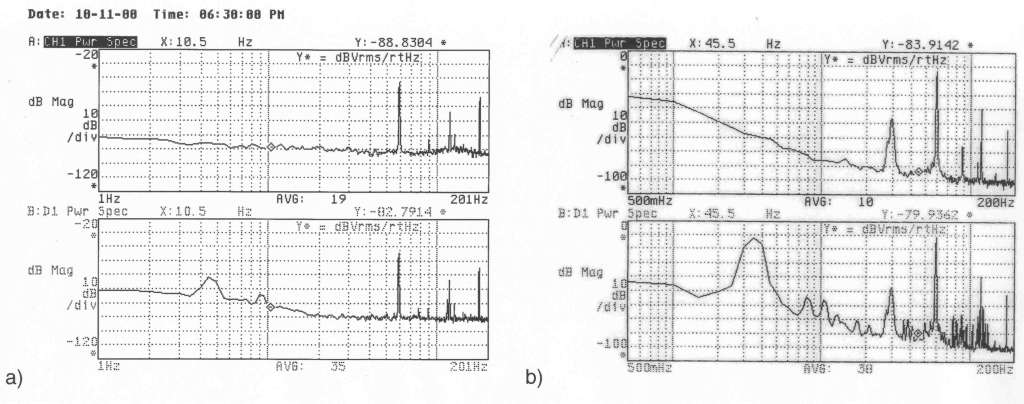
a) in zero field. -100 dB = 25 fT/√Hz. b) in Earth’s field. -100 dB = 250 fT/√Hz.
The figure above shows operation of a Tristan model HTM-8 HTS SQUID magnetometer (50 fT/√Hz sensitivity) in both zero and 0.5 gauss (Earth’s field) environments. The upper trace in both figures is that of the SQUID magnetometer measured in a liquid nitrogen bath. The lower trace is the same SQUID connected to the 77 K pulse tube. As can be seen, for all frequencies above 20 Hz, Tristan’s implementation of direct cryocooling of a HTS SQUID sensor introduces no magnetic noise. Even at 1 Hz, the induced field noise from the cryocooler is only a factor of 10 above SQUID noise.
Tristan has also developed a series of cryocooled LTS SQUID magnetometers using a 1/10th watt Gifford-MacMahon cycle refrigeration. The GM cryocooler first liquefies helium gas and then sufficient refrigeration to keep the helium liquefied during system operation. Depending on the configuration of the detection coils, the design allows measurements to be taken at or near SQUID sensitivity without the cryocooler inducing magnetic or vibrational noise.
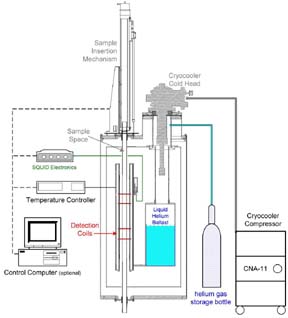
For ultra-sensitive measurements, the cryocooler can be turned off. There is sufficient liquid helium ballast to operate the SQUID magnetometer system for more than a day without restarting the cryocooler. This technology is used both in Tristan’s model DRM-300 rock magnetometer (http://www.tristantech.com/pdf/DRM-300datasheetv1.pdf) and a series of OEM susceptometers.
Consulting
Tristan has performed contract R&D for a number of private companies and research organizations, both in the United States and in foreign countries in areas ranging from underground detection and corrosion analyses to custom biomedical products. Contact Tristan for details regarding assistance in the areas of cryogenics, magnetic sensing and electronics.
Internal R&D
Since its original founding in 1991, Tristan and its key personnel have produced a number of custom measurement systems for a variety of applications. Some of them are listed here:
Multiple single- and multi-channel SQUID magnetometers for NDE and paleoarcheology use. These are state-of-the-art systems, some with spatial resolutions approaching 1 µm.
High Speed Data Acquisition System for SQUID electronics: These electronics, developed for a major telecom supplier offered >100 kSample/second acquisition of 24 bit words for a large (>70 channel) SQUID array. The data acquisition system had the capability of storing over ¼ terabyte of data.
A six-channel system for Vanderbilt University for general purpose NDE studies.
Comprised of a magnetometer, dewar, electronics, software and multiple magnets, this system has extremely high sensitivity (10-14 tesla) and sub-mm resolution.
A three-channel Superconducting (SQUID) NDE system for use by a large Japanese steel company, comprising magnetometer probe, dewar, superconducting magnets, custom electronics, and custom software. Using a welding robot, this compact system is scanned over samples.
A dual-channel magnetometer system for use by a private company to study materials for nuclear-fuel rod integrity. The package includes a magnetometer probe, dewar, computer controlled sample scanner, electronics and software.
A compact (12″) six-channel high sensitivity susceptometer capable of generating tesla fields and operating in both vertical and horizontal orientations. The ultra-compact system, when attached to the end of a robot arm, is used by a large Japanese nuclear reactor inspection company for scanning the interior of nuclear pressure vessels.
The first commercial scanning magnetic microscope (SMM-1000) to study small electronic circuits and material samples. This comprised a dewar, cryogenic sample handling stage, magnetometer, custom software, vacuum system, and custom electronics. It is comparable to a SEM in complexity. Nine detection coils were fabricated in a linear array with 100 µm coil separation. Spatial resolution was at the µm level.
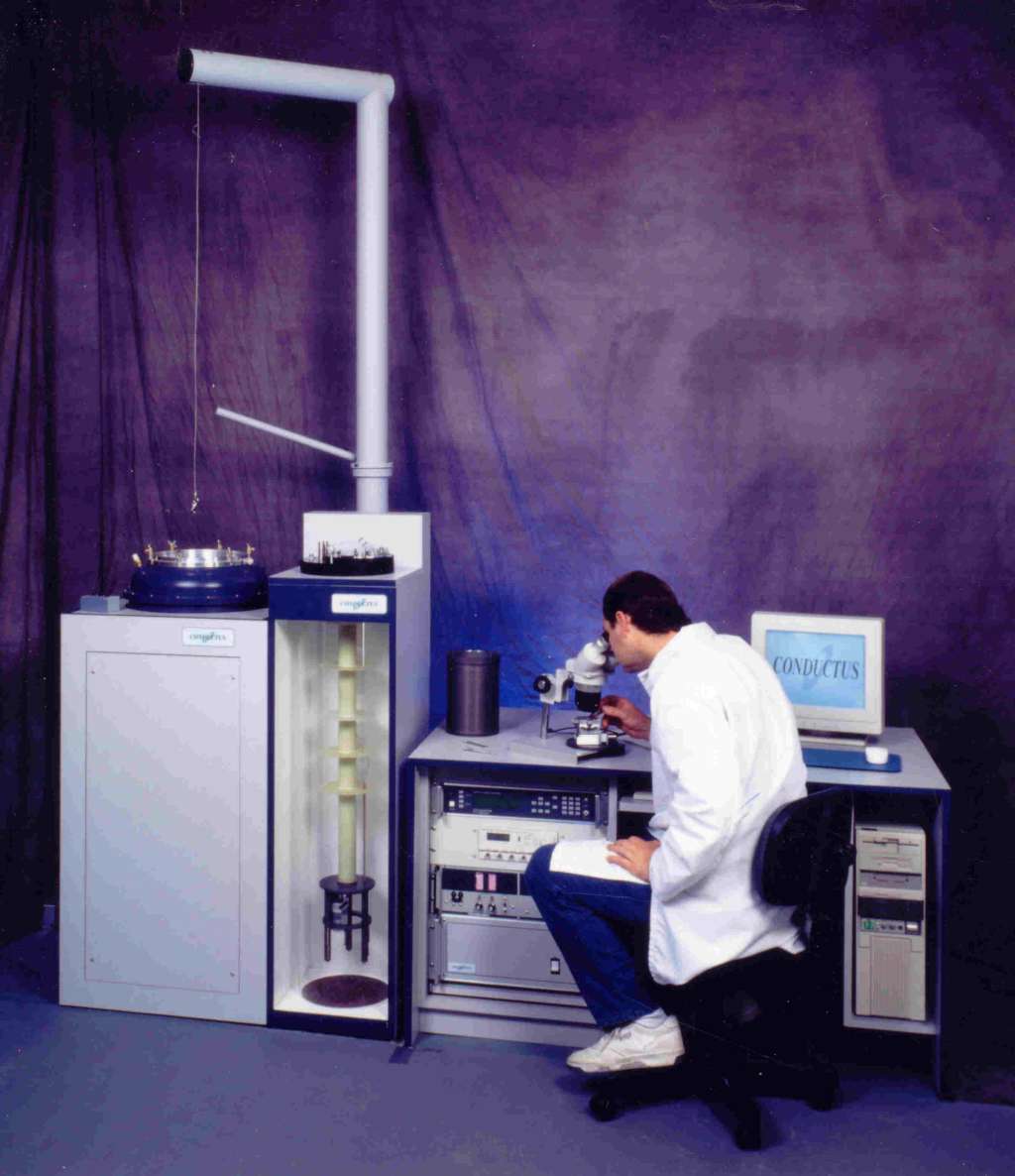
A DC and AC susceptibility variable temperature and field platform. Twelve systems were made. These systems integrated SQUID magnetometers, sample motion control, sub-mK thermal control from 2 – 350 K, variable applied fields to 17 T and truly user friendly automated control software. This product demonstrated Tristan’s ability to produce state-of-the-art complex analysis equipment with minimal user requirements.
An AC susceptibility variable field platform for an OEM customer. These systems offered closed cycle refrigeration along with automated sample insertion and measurements. The automated sample handling allowed up to 96 samples to be measured without human intervention.

